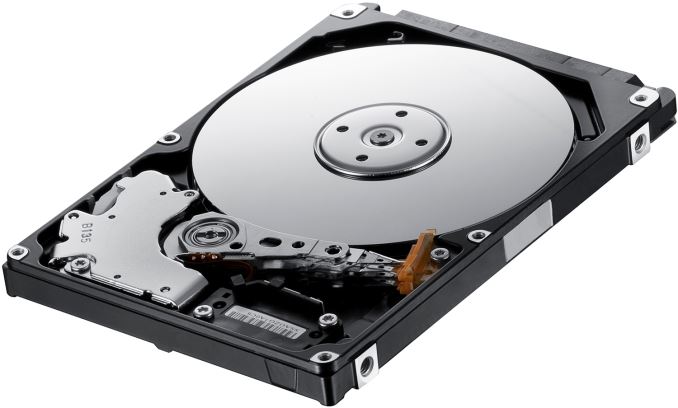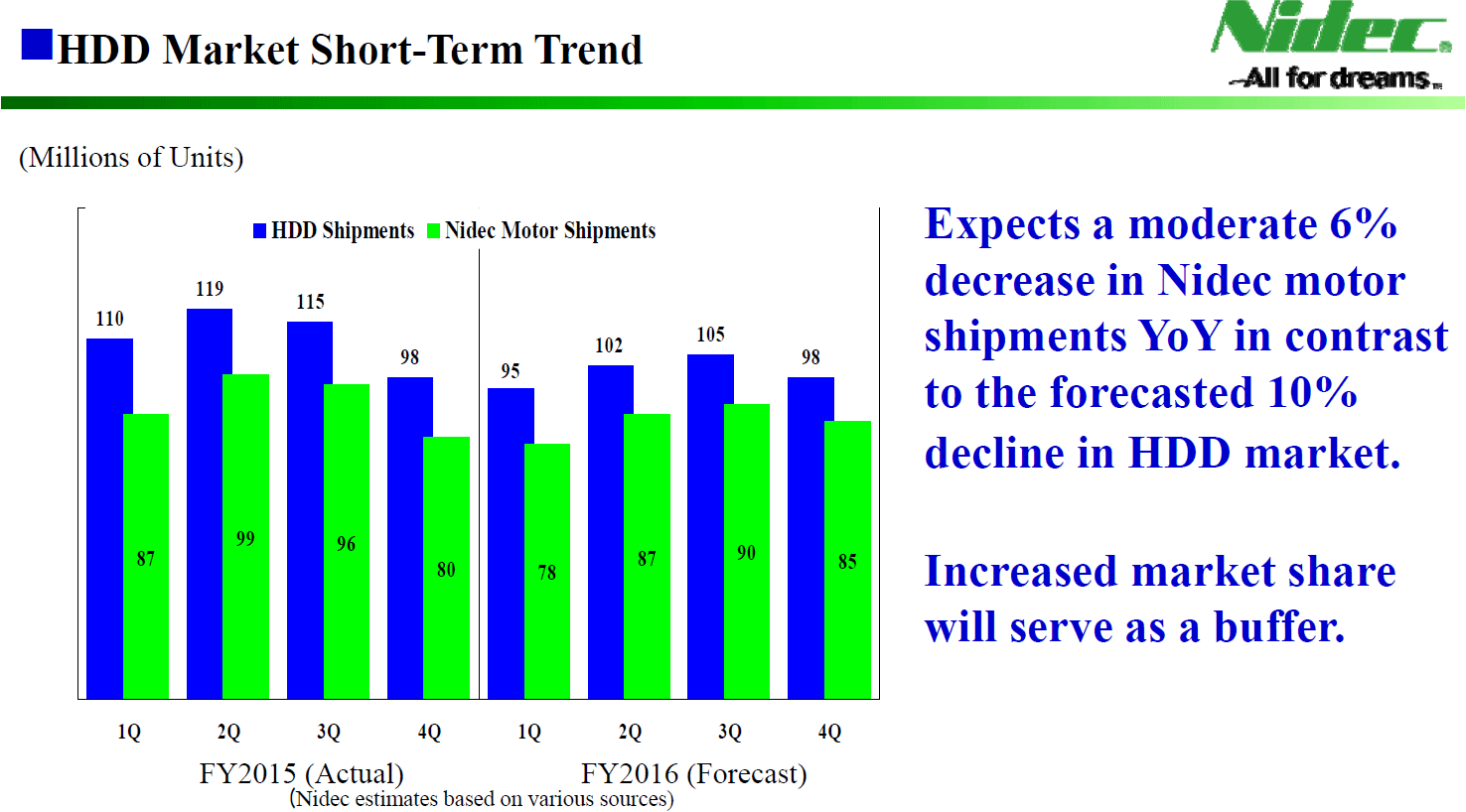Market Views: HDD Shipments Down 20% in Q1 2016, Hit Multi-Year Low
by Anton Shilov on May 12, 2016 8:00 AM ESTFinal Words
The storage market in the first quarter of 2016 performed in accordance with the PC market trends in general. Shipments of HDDs went down, but sales of high-capacity nearline hard drives remained a bright spot in the reports of leading hard drive suppliers. Western Digital remains optimistic in the short term for HDDs, but Seagate detailed plans to severely cut its production capacities and to reduce its presence the market of low-end mobile HDDs.
As ultra-thin notebooks, as well as 2-in-1 hybrid PCs, are gaining market share, the potential for 2.5” client HDDs suffers. Theoretically, sales of 2.5” drives for AIO and small form-factor desktops could offset declines in the mobile (at the expense of 3.5” HDDs declines), but this did not happen in Q1: sales of Seagate’s 2.5” client HDDs dropped to 10.6 million units (down 37% YoY), whereas shipments of Western Digital’s 2.5” client drives declined to 13.577 million units (down 28% YoY).
This quarter Seagate announced plans to discontinue some of its 2.5” low-capacity (500 GB and lower) client drives and concentrate on promoting 1 TB and 2 TB 2.5” models based on its latest technologies. Basically, Seagate no longer wants to compete against entry-level TLC NAND-based SSDs in low-end and mainstream notebooks. Reducing participation in this market segment will allow Seagate to simplify the portfolio of components it purchases from other makers and cut down its costs as high-capacity platters for advanced drives are made mostly in-house. It will be very interesting to see how other HDD makers respond to this action. They face similar problems and eventually it will only get harder to compete against cheap SSDs.
Shipments of 3.5” client hard drives hit a new low in the first three months of this year, which was not completely surprising, given slow shipments of PCs. So far neither Seagate nor Western Digital has announced plans to optimize their 3.5” lineups (WD actually folded its Green drives into its Blue lineup last year), but this is something that will likely happen in the future.
Enterprise HDD business is a mixed bag these days. On the one hand, sales of 10K and 15K HDDs are declining because of SSDs and that decline has yet to bottom out. Yet, those hard disks remain expensive and the business overall is profitable. On the other hand, sales of nearline drives are on the rise. More importantly, the growth of average capacities of such HDDs even outpaces the growth in their unit sales. Interestingly, Seagate indicated that demand for high-end 8 TB nearline HDDs was so strong in Q1 2015 that it could not even fulfill the orders placed. Seagate’s rather unexpected start of 10 TB HDD revenue shipments in April proves that operators of data center are rapidly building up capacities.
Seeing the fact that HDD sales volumes have been falling for many quarters now, Seagate not only decided to exit the market of low-end notebook drives but also detailed its plans to steeply cut-down its manufacturing capacities to 35 – 40 million units per quarter from 55 – 60 million units per quarter. From now on, the company will focus on high-capacity HDDs that are sold at higher prices rather than on affordable drives for bulk storage, which will naturally help it to avoid direct competition against SSDs in the entry-level segment where capacity may not be that important. It remains to be seen what Seagate will do with the manufacturing equipment that it will not need after its optimizations, but that is a different conversation entirely.
Looking ahead, Western Digital believes that the HDD TAM will remain above a psychologically important 400 million units per year mark (shipments of HDDs last year were around 453.6 million units), but will drop in the long term. Meanwhile, Nidec conservatively predicts that HDD TAM will fall to 400 million units in 2016 with shipments of PC and external HDDs declining the most. The upcoming quarters will show whether optimistic or conservative predictions are applicable to today’s HDD market.
Methodology and Important Notices
There are three major manufacturers of hard drives today: Seagate, Toshiba and Western Digital. Other suppliers are reselling hard drives made by these three companies.
Seagate and Western Digital reveal their HDD unit shipments as well as TAM (total available market) estimates every fiscal quarter. While such numbers are considered preliminary, they are usually rather accurate and re-affirmed by third-party analysts. Our TAM is the midpoint between Seagate’s and Western Digital’s TAM estimates. If only one hard drive maker reveals its TAM, we consider the number from only one vendor.
Meanwhile Toshiba does not officially disclose its HDD shipments. We subtract quarterly shipments of Seagate and Western Digital from our TAM estimate to get the number of drives sold by Toshiba. The approach is is the reason why we do not report historical shipments of Toshiba prior to Q3 2012. Based on estimates of hard drive makers and industry observers, Toshiba cannot produce more than 22 – 23 million of HDDs per quarter.
Seagate’s and Western Digital’s fiscal quarters end on the last business day of the last week of a calendar quarter (e.g., the Friday next to December 31). While fiscal quarters of HDD makers may not correspond exactly to calendar quarters, they are very close. Fiscal years of Seagate and Western Digital do not correspond to calendar years as they begin in July.
Historical TAM data comes from financial reports of Seagate and Western Digital.
Note 1: Seagate completed the acquisition of Samsung’s HDD business in December, 2011. The company started to include sales of Samsung-branded HDDs in its quarterly shipments in Q1 2012 (Q3 FY2012).
Note 2: Western Digital closed the acquisition of Hitachi Global Storage Technologies in March, 2012. Western Digital began to include HGST shipments in its financial reports in Q2 2012 (Q4 FY2012).
Note 3: Toshiba acquired some of Western Digital’s 3.5-inch HDD manufacturing equipment and intellectual property in May, 2012. It was expected that the manufacturing transfer could be complete within 6 to 12 months. Western Digital made HDDs for Toshiba on a contract basis until late Q4 2012. Due to the contract manufacturing agreement between Western Digital and Toshiba in 2012, there may be some inaccuracies in the historical data in that period (i.e., since the drives were made by Western Digital and then sold to Toshiba, they are attributed to the former, not the latter).
Note 4: Seagate defines client HDDs as 2.5” and 3.5” hard drives for desktops, notebooks and hybrid PCs as well as game consoles. Seagate considers HDDs for external storage and network-attached storage (NAS) as “branded” drives. Hard disks for DVRs and surveillance systems belong to Seagate’s family of HDDs for consumer electronics. Enterprise lineup includes 2.5” and 3.5” drives for mission critical (SAS, SCSI, Fibre Channel), enterprise storage, nearline and other datacenter applications.
Note 5: Western Digital attributes desktop and mobile 2.5” and 3.5” hard drives to client HDDs. External hard drives and NAS are referred to as “branded products”. Western Digital’s consumer electronics HDDs are used in DVRs, game consoles, video streaming applications and security video recording systems.












116 Comments
View All Comments
tamalero - Tuesday, May 17, 2016 - link
with the advent of netflix, I actually wonder if its worth expending that much on local storage with a plex/emby server running locally.Still, 4 tb drives are now reaching the 100 USD barrier. Which is hella cheap.
You can easily buy a good array for what used to cost thousands.
Wolfpup - Thursday, July 14, 2016 - link
I don't save much video, but even still I keep some shows from my Tivo, and broadcast TV is a (glorious) 7.5GB/hour or so. And as someone mentioned, comics-I've got GB of stuff from Humblebundle. And we didn't used to have to store our games, since they actually bothered putting them on disc. I've long since surpassed what my 4TB drives can hold, and moved on to 8TB ones just for my games from GOG.com and Steam...Murloc - Thursday, May 12, 2016 - link
some people systematically rip everything they buy, but it's home cinema audiophiles with projector kind of people. Very rare.bji - Friday, May 13, 2016 - link
Nothing more disgusting than people who pirate things they don't even need just because they're so in love with the idea of hoarding pirated goods.Oh yeah and then they bitch about the cost of the hard drives that they use to store their pirated goods. Truly classy.
DanNeely - Friday, May 13, 2016 - link
If they bought the disk they're not pirating it. The pirates are the people renting disks from Redbox (or old Netflix) and ripping them.Arbie - Saturday, May 14, 2016 - link
Why exactly is that disgusting? Does pirating something you don't need / won't use / wouldn't have bought hurt anybody at all? Seems like all it does is sell more hard drives. Maybe your post was facetious; if so you need to get a little better at that.Wolfpup - Thursday, July 14, 2016 - link
Murloc specifically said *BUY*, not seal. I don't even feel like I buy that much anymore, but still have piles of CDs, DVDs, etc.mindless1 - Wednesday, February 15, 2017 - link
"Nothing"? Really? I can think of thousands of things more disgusting, including your judgemental attitude and the stranglehold that certain content developers are provided in the US and their John Doe persecution of people they don't even have sufficient evidence of piracy against, despite reporting record profits then instead claiming massive piracy losses.Supporting those deceitful !@#$ is far more disgusting to me.
Death666Angel - Thursday, May 12, 2016 - link
"but I rarely have anyone ask about how to store even BR-D-quality video, so I'm skeptical that 4K will become a serious driver of increased household storage needs this decade. (At least at the consumer level.)"My guess is, people who need you to build them a rig or give them advice, aren't the sort of people into ripping movies in the first place. They are probably fine with tossing the blu ray into their player, hit play, watch it once and then put it in the attic. :D I'm waiting for a more serious shift in prices to get another bunch of 4TB drives for my fileserver (currently 2x[4x2TB] with at 7 more 3.5" bays empty).
JoeyJoJo123 - Thursday, May 12, 2016 - link
Except HDD prices haven't significantly changed in the last 2-3 years, following the normalization of prices after the floods.They don't seem to be changing anytime in the near future either; in fact, it may just go up as HDDs die off and exit the market.